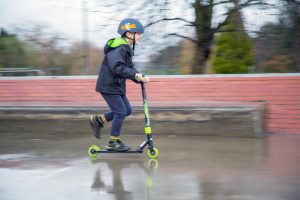We’ve all seen the joy on a child’s face when they master riding a scooter. It’s not just fun, but also a fantastic way to develop their balance skills. When we think about balance, it’s not just about standing straight; it’s a crucial skill that aids in our daily activities, and it’s even more critical for kids in their growing years.

Scooters can be instrumental in this balance training. We understand how important it is to ensure our kids are safe while they learn. That’s why this article is here to guide you on how to pick the right scooter, teach your child to ride safely, and create an enjoyable and structured environment for them. It discusses how to incorporate scooter riding into physical activities such as jogging, cycling, and yoga, as well as how to recognize and reward their progress.
Key Takeaways
- Balance training through scooter riding is crucial for kids’ physical abilities and cognitive development.
- Choosing the right scooter for your child is essential for safety and maximizing balance training benefits.
- Teaching a child to ride a scooter involves starting on a flat surface, showing them how to use the brake, and encouraging balance.
- Essential safety measures for scooter riding include wearing a helmet, knee, and elbow pads, and using a scooter suitable for their age, size, and skill level.
The Importance Of Balance Training

It’s crucial for kids to engage in balance training as it not only boosts their physical abilities but also enhances their cognitive development.
Balance exercises are an excellent way for children to improve their overall stability and coordination benefits, as it challenges their bodies in new and exciting ways. Encouraging kids to participate in balance training can help them to become more self-aware, improve their focus, and even boost their confidence.
It’s a wonderful way to serve our children by helping them develop essential skills that will benefit them in many areas of life. The beauty of balance training is that it can be fun too!
In our next section, we’ll delve into how scooters can play a significant role in this exciting journey of skills and balance training.
How Scooters Can Help With Balance Training
Zooming around on those two-wheeled chariots not only ignites a sense of freedom in riders but also presents an undeniably thrilling method to enhance coordination and stability. Scooters are excellent tools for balance training, helping kids develop motor skills while having fun.
The constant shifting of weight and adjusting to maintain balance hones their proprioceptive skills. Regular scooter maintenance ensures a smooth ride, reinforcing this learning process. We can also introduce balance games to add an element of playfulness while putting these skills to the test. From dodging cones to participating in relay races, these games can make the learning process more enjoyable.
Choosing the right scooter for your child is crucial to ensure their safety and maximize the benefits of balance training. This exciting journey awaits them in the next section.
Choosing The Right Scooter For Your Child
Navigating the myriad options available to you when selecting the perfect two-wheeled chariot for your little one can be an exhilarating task. We’re here to help you make that choice with ease and confidence.
Consider customization; it can be a fun way to engage your child in the process. Personalization options might include choosing the color, adding stickers, or even selecting unique wheel designs.
Child-friendly brands are also an important factor. These brands often design scooters with safety and ease of use in mind, creating a seamless learning experience for your young one.
The perfect scooter not only trains balance but sparks joy and a sense of ownership.
Now that we’ve chosen the right scooter, let’s explore how to make your child’s first ride unforgettable.
Teaching Your Child How To Properly Ride A Scooter
Once they’ve got their new set of wheels, teaching your kiddo to ride can truly be a thrilling adventure. We must remember that mastery takes time, patience, and continuous practice.
Start on a flat, smooth surface to let them get a feel for the scooter. Show them how to use the brake and encourage them to keep a firm grip on the handlebars. A good way to build confidence is by letting them push off with one foot while balancing on the other.
Regular maintenance will ensure a safer ride, and choosing reputable scooter brands can provide added assurance. As our children engage in this activity, it’s not only fun but also a great form of exercise that benefits their health. Be there to guide them, cheer them on, and be their safety net.
Now that they’re starting to get the hang of it, we can now introduce essential safety measures to further protect them. Ensure they always wear a helmet and other protective gear for added security.
Essential Safety Measures
As you embark on this journey with your little one, it’s crucial to instill in them the importance of protecting themselves while they explore their newfound freedom. Safety measures are not just about rules, but about creating a secure environment for them to develop their balance and coordination skills.
Firstly, the helmet necessity cannot be overstated. Choose a helmet that fits properly and is designed for scooter use.
Secondly, protective gear, such as knee and elbow pads, should be worn to prevent scrapes and bruises.
Lastly, ensure the scooter is suitable for their age, size, and skill level.
Remember, the goal is not to wrap them in bubble wrap, but to equip them with the knowledge and tools to navigate safely.
Now, let’s talk about the crucial role parents play in fostering these safety habits.
The Role Of Parents In Encouraging Safety

After exploring the importance of essential safety measures, let’s turn our focus to the crucial role we, as parents, play in promoting safety.
Parental supervision is more than just a watchful eye; it’s about actively engaging with your child, teaching them the rules of the road, and instilling a sense of responsibility. This proactive involvement is key to injury prevention.
By setting boundaries, teaching safe habits, and encouraging smart decisions, we can help our children develop their balance and coordination in a secure environment. This parental engagement doesn’t just safeguard kids from potential harm but also fosters their love for scooter riding.
So, let’s dive into how we can make this balance training exercise a fun-filled, structured, and safe experience for our little riders.
Creating A Fun And Structured Environment
Creating a structured environment for your child’s two-wheeled adventures isn’t just about rules and restrictions; it’s also about making sure they’re having a blast. We can help by providing scooter decoration ideas, adding a personal touch to their ride.
Encourage your child to express themselves through stickers, paint, or even DIY crafts. This can make their scooter stand out, igniting their enthusiasm to ride more often.
We can also encourage playdates with scooters, bringing together children with similar interests. This not only enhances their social skills but also fosters a healthy competitive spirit, making balance training more enjoyable.
The fun-filled environment we create, combined with safety measures, will ensure our children derive maximum benefit from riding.
As we move forward, let’s explore how we can incorporate scooter riding into daily physical activity for a healthier lifestyle.
Incorporating Scooter Riding Into Daily Physical Activity
Rolling through the neighborhood on two wheels can be a fantastic way to weave daily physical activity into your child’s routine. Scootering offers a unique opportunity for balance training while encouraging kids to be active and explore their surroundings. But before we hit those pavement hills, let’s remember a few essentials.
- Scooter maintenance basics: Regularly checking the tires, brakes, and handlebars ensures a smooth and safe ride.
- Setting boundaries: Limit riding to safe, designated areas where kids can easily be supervised.
- Community scooter programs: These offer fantastic opportunities for children to interact, learn, and grow their skills in a safe, structured environment.
Incorporating scooter riding into daily activities not only boosts physical health but also aids in mastering balance skills. Now, let’s shift gears and focus on recognizing and rewarding progress in balance skills.
Recognizing And Rewarding Progress In Balance Skills
When you see your child teetering with confidence and maintaining their footing, it’s a proud moment that deserves recognition and rewards.
At this point, reward systems become a valuable tool. These can range from verbal praise to small tangible tokens. The aim is to positively reinforce their progress, boosting their self-esteem and encouraging continuous improvement.
Progress tracking is another essential aspect. We recommend using a chart or a diary to record your child’s development. This not only provides a visual representation of their progress but also helps identify areas that need more practice.
Remember, safety and fun should always be the cornerstone of this journey. Now, let’s delve into how we can spice things up with advanced skills and tricks for continued balance training.
Advanced Scooter Skills And Tricks For Continued Balance Training

It’s time to step things up a notch with more challenging stunts and maneuvers that’ll not only keep your youngster engaged but also help them master their equilibrium. As they progress in their scooter skills, trick execution becomes an exciting part of their journey.
Always emphasize the importance of scooter safety, and ensure they always wear a helmet. Taking proper safety precautions is essential, especially when they’re diving into this intense physical activity. For beginners, starting with training wheels can provide an extra layer of security as they learn the ropes.
Here are a few advanced tricks they can try:
- Bunny Hop: This trick involves jumping with the scooter while maintaining balance.
- Tail Whip: This trick requires spinning the deck around while jumping.
- Bar Spin: This trick involves spinning the handlebars in mid-air.
- Manual: This trick challenges them to ride only on the back wheel.
- Fakie: This trick tests their balance by riding the scooter backward.
Remember, skill progression is all about patience, practice, and, most importantly, safety.
Conclusion
We’ve shown you how scooters can be a fun and safe way to improve your child’s balance skills. Moreover, scooting is not only fun but also a fantastic form of exercise with numerous health benefits. We want to make sure you have the right scooter, safety measures, and a structured environment so that your child can develop their balance skills while having a blast.
So, be sure to check out our selection of scooter models for kids, and the safety gear like helmets and elbow and knee pads that come along with them. It’s crucial for them to wear protective gear, especially considering the potential risks of head injuries. By wearing a helmet and other protective gear, they can safely practice advanced tricks and continue developing their balance skills.
Don’t forget to share your experience with us, and other parents, on our website and social media pages! Let’s get those helmets on and start scooting toward better balance together!
Frequently Asked Questions (FAQs):
How Do You Practice Balancing On A Scooter?
Improving balance on electric scooters requires practice and patience. Choose a flat, smooth surface for a scooter ride and hold onto the handlebars while standing with one foot on the deck and the other on the ground. Gently press down on the throttle, allowing the e-scooter to move forward slowly while pushing off with your grounded leg. Engage your core muscles to maintain control over your body weight as you increase your speed incrementally. Integrating this activity into your daily routine will help enhance overall balancing skills.
How Can You Be Safe On A Scooter Ride?
Safety should always be a top priority during electric scooter rides; wearing a helmet protects the head and obeying traffic laws are crucial steps in ensuring rider safety. Be attentive to potential hazards such as pedestrians, vehicles, or obstacles that may come into your path. Furthermore, maintaining control over speed and being aware of environmental factors that might affect stability is essential for a safe ride. A few minutes of delay is not as fatal as an accident.
Do Scooters Help Kids With Balance?
Yes, scooters can aid children in honing their balancing skills from an early age by engaging their lower body muscles—particularly leg muscles—and hip flexors as they step onto the scooter’s deck and shift their extra weight during movement.
What Is The Safety Of Motor Scooters?
Motorized scooters present unique risks due to their limited safety features compared to cars or bikes; however, riders can mitigate these risks by adhering strictly to traffic rules and wearing proper protective gear such as helmets and reflective clothing. Proper control over body weight and balance is also essential for preventing injuries while riding.
What Is The Use Of Self-Balancing Scooter?
Self-balancing scooters operate using tilt sensors combined with gyroscopic sensors that provide a smooth riding experience controlled entirely by subtle shifts in body weight. This technology offers various benefits such as eco-friendliness (as they run on battery power), affordability, convenience for short-distance travel, low maintenance costs, and ease of use.
What Are The Advantages Of Self-Balancing Scooters?
Riding a self-balancing e-scooter regularly can have several positive effects on personal well-being by incorporating physical activity into day-to-day life via exercise that targets core strength and whole-body coordination. Additionally, it fosters eco-friendly habits by utilizing battery-powered transportation instead of gas-guzzling vehicles.
Parents can help children build their balancing abilities by encouraging them to practice standing flat-footed on the scooter deck floor, in appropriate footwear. Gradually increasing the distance traveled during rides, as they become more comfortable balancing themselves, will contribute to improved overall well-being and fitness in their daily lives.
How Can You Prevent A Scooter Accident?
A smooth and safe scooter ride involves various factors such as maintaining control over speed, engaging core muscles for stability, adhering to traffic rules, wearing necessary protective gear like helmets, being mindful of potential hazards, and having proper hand placement on handlebars for precision steering. To prevent accidents with self-balancing scooters, always wear protective gear (helmets), and avoid riding on rough or uneven terrain or at night when visibility is poor. It’s essential to obey speed limits and follow traffic laws while staying cautious of any potential obstacles that may arise underfoot or in the rider’s path.
What Is The Best Way To Ride A Scooter?
The ideal standing position for riding an e-scooter involves placing one foot on the deck and the other on the ground while holding onto the handlebars. As you begin to move, shift your body weight accordingly and engage your core muscles to maintain balance. As you become more comfortable, increase your speed and distance incrementally. Implementing this practice into your daily routine can lead to improved fitness levels, better coordination, and enhanced overall well-being.
What Are The Most Common Scooter Accidents?
In examining scooter-related mishaps, several classifications surface frequently. Among these are broken bones – a typical result of falling off a scooter. Head injuries also appear regularly in incidents involving scooter riders. Likewise, sprains and strains often feature in these circumstances as well. Last, but certainly not least, lacerations and road rash represent another category of common afflictions associated with scooter accidents.
To feel safe during a scooter ride, it’s essential to wear appropriate protective gear like helmets; adhere strictly to traffic rules; maintain control over speed; be aware of potential hazards in the environment; ensure proper hand and arms placement on handlebars for accurate steering; stay mindful of weather or road conditions that could impact stability or control.
How Can I Help My Child With Balance?
During scooter rides, riders primarily engage their lower body muscles such as legs (including leg muscles), knees, and hip flexors along with core muscles to maintain balance while shifting body weight during movement. Regularly riding a scooter can help strengthen these muscle groups.
DISCLAIMER (IMPORTANT): This information (including all text, images, audio, or other formats on FamilyHype.com) is not intended to be a substitute for informed professional advice, diagnosis, endorsement or treatment. You should not take any action or avoid taking action without consulting a qualified professional. Always seek the advice of your physician or other qualified health provider with any questions about medical conditions. Do not disregard professional medical advice or delay seeking advice or treatment because of something you have read here a FamilyHype.com.